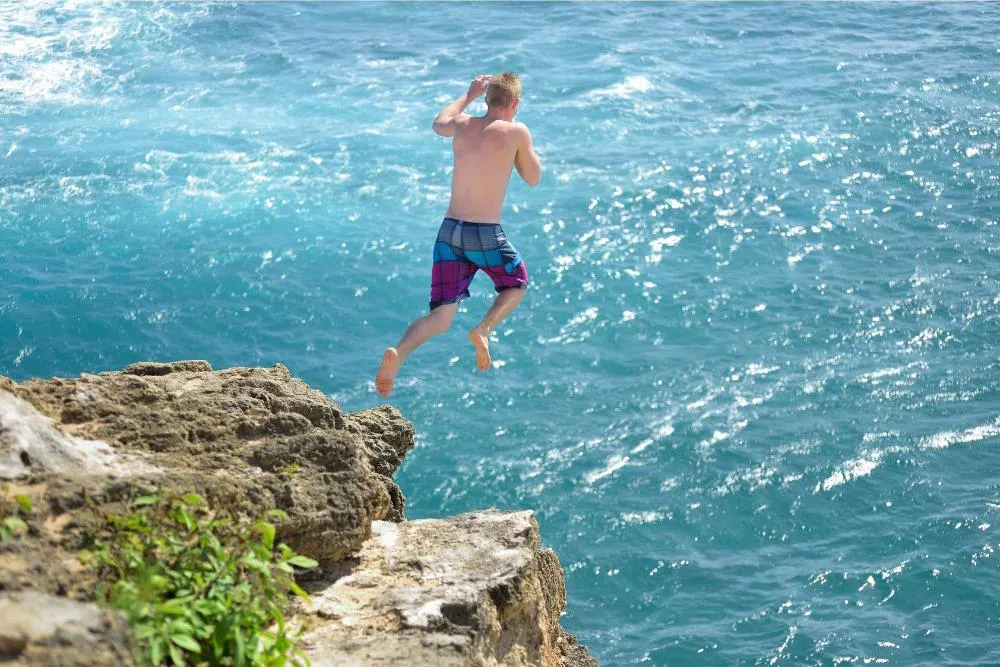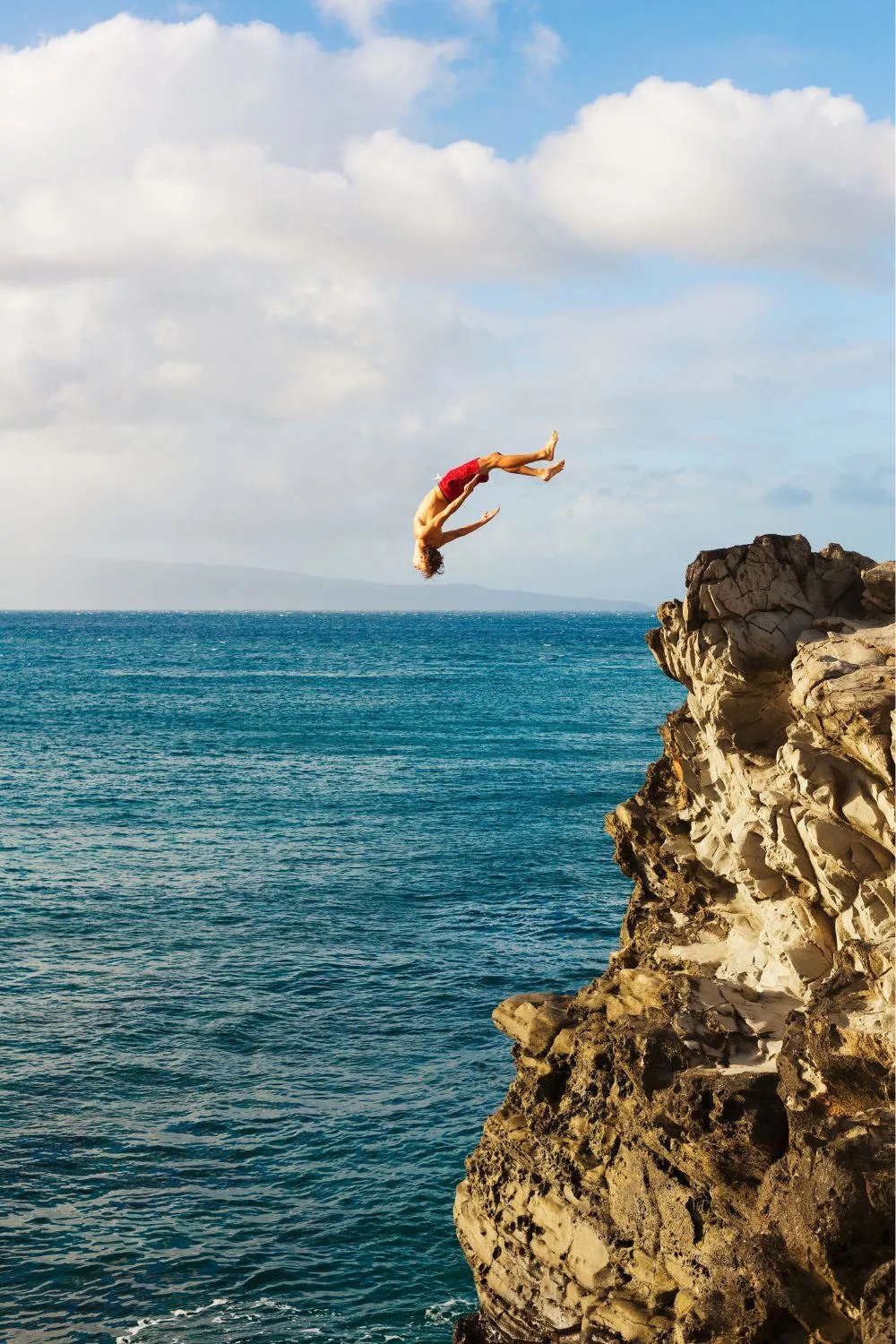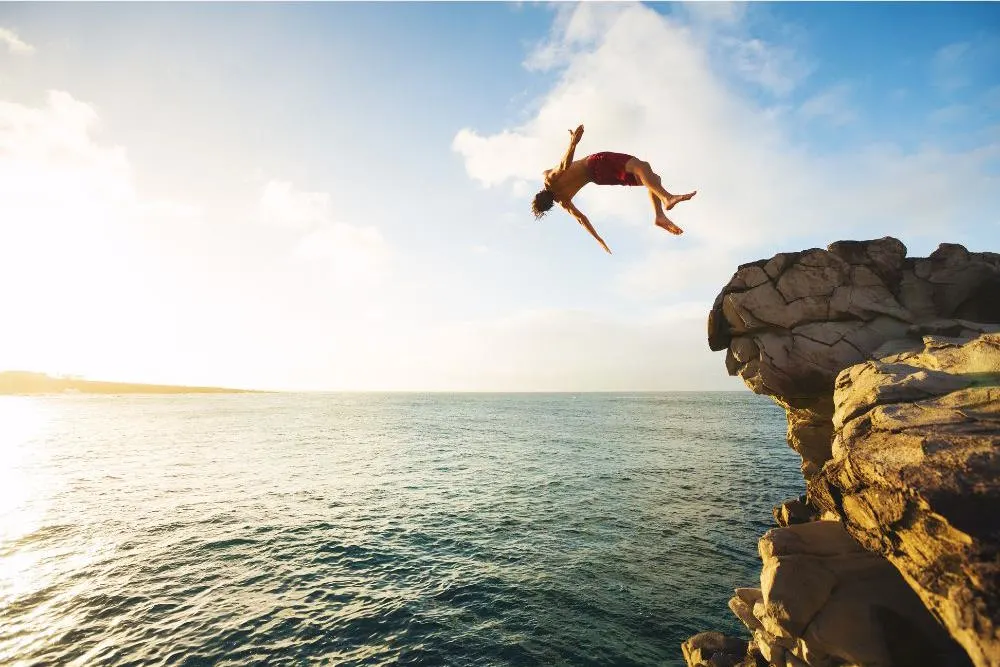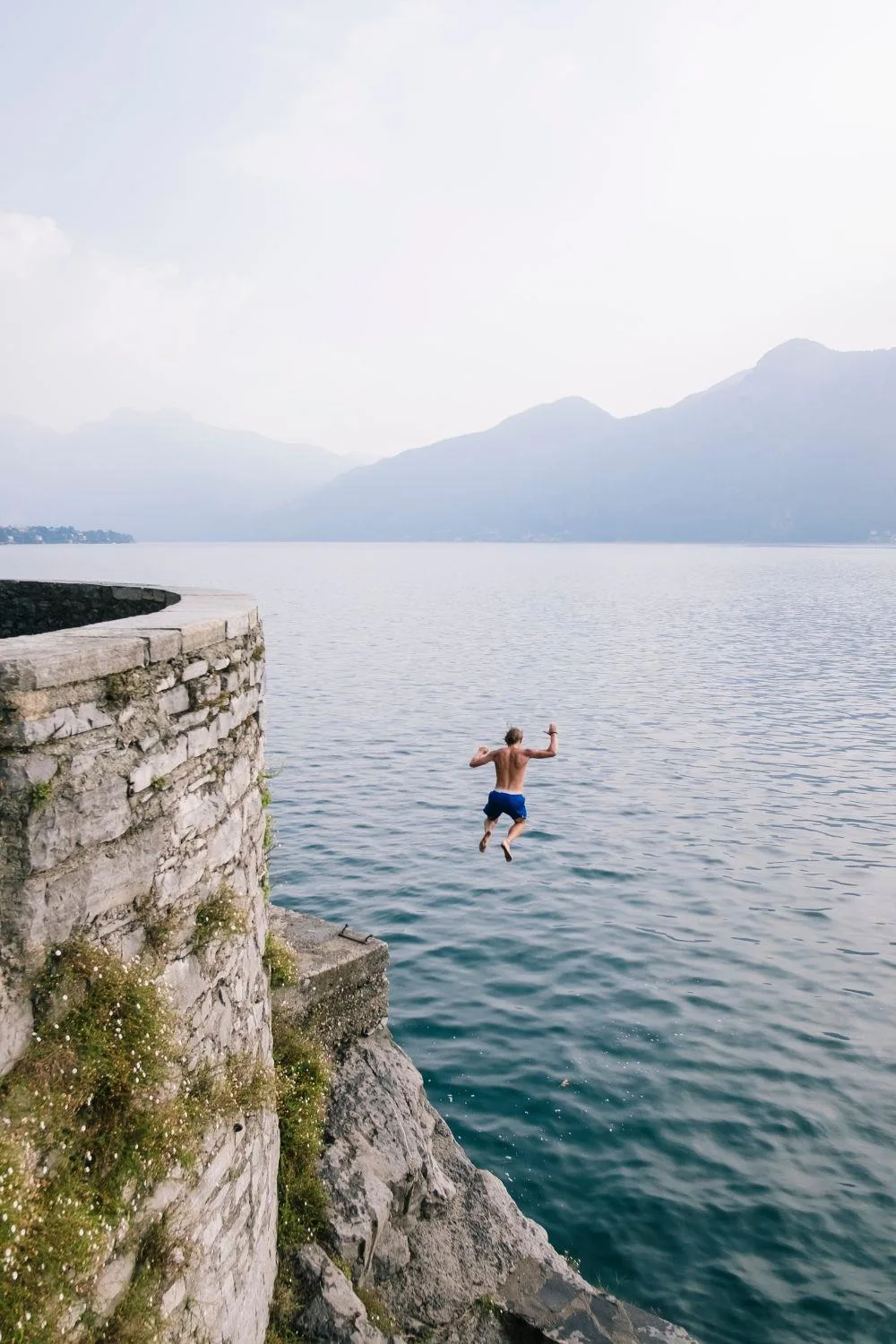Cliff diving is both an exhilarating and challenging sport that pushes the limits of athletic ability, courage, and skill.

For thrill-seekers looking to take their love for heights and diving to another level, pursuing a career in cliff diving may be a captivating endeavor. Before jumping into this intense activity, it’s essential to understand the necessary steps and safety precautions to excel and reduce the risk of injury.
Successful cliff divers possess exceptional physical strength, aerial awareness, and precise timing, all of which contribute to a safer and aesthetically pleasing dive. It’s crucial to first master diving skills at lower altitudes and gradually progress to higher cliffs as confidence and abilities improve. Some aspiring cliff divers might even consider competing in the prestigious Red Bull Cliff Diving World Series to showcase their talent on a global stage.
When contemplating a journey into the world of cliff diving, it’s important to prioritize safety and maintain a strong commitment to improving technique and fitness. With practice, dedication, and proper guidelines, becoming a cliff diver can be an incredibly rewarding and adrenaline-fueled pursuit.

Understanding Cliff Diving
The Origins and History
Cliff diving can be traced back centuries to its roots in Hawaii. Legend has it that King Kamehameha, a revered Hawaiian ruler, would demonstrate his courage and authority by leaping from tall cliffs into the ocean below. This ancient practice eventually evolved into the thrilling extreme sport we know today.
The first recorded cliff diving competitions took place in the 18th century, showcasing the incredible physical feats of athletes from around the world. Today, the sport has gained international recognition and a dedicated following.
Cliff Diving as an Extreme Sport
Cliff diving is not for the faint of heart. Athletes leap from heights of up to 85 feet, experiencing a free fall for just a few seconds before plunging into the water. Speeds can reach approximately 53 miles per hour during the descent, making it an adrenaline-pumping experience for both divers and spectators.
This extreme sport demands not only courage but also exceptional athletic ability. Divers must possess excellent aerial awareness, flexibility, and core strength to execute intricate stunts mid-air before entering the water with minimal impact. Proper technique is crucial for safe diving, as the potential risks involved are significant.
Despite these hazards, cliff diving has gained a passionate following over the years. Events like the Red Bull Cliff Diving World Series showcase the beauty, artistry, and athleticism of this sport, celebrating its unique blend of daring and discipline.
In summary, cliff diving is an exciting extreme sport with a rich history rooted in ancient Hawaiian traditions. It requires remarkable skill, strength, and courage, making it truly awe-inspiring to watch and experience.

Becoming a Cliff Diver
Training and Preparation
To become a successful cliff diver, it is essential to have a strong foundation in training and preparation. This involves both physical and mental preparation. Physically, a potential cliff diver should be in excellent shape and should engage in regular workouts to build strength, flexibility, and endurance. Some key exercises include swimming, running, and core strengthening exercises such as planks and sit-ups.
Mental preparation, on the other hand, is crucial to overcoming the fear of heights and ensuring a focused approach during dives. Techniques such as visualization, deep breathing exercises, and meditation can be helpful in improving mental strength and resilience.
Gaining Experience
Before attempting high cliff dives, it is important to start with lower heights and gradually progress as your skills and confidence increase. Dive from a variety of heights in different environments, including natural cliffs and diving platforms, to gain valuable experience. Begin by mastering basic dives and working on perfecting your form and technique.
Joining a diving club or seeking guidance from experienced divers can provide invaluable support and opportunities for practice. Participating in diving competitions can also help improve your skills and ease the transition from traditional diving to cliff diving.
Developing Acrobatic Skills
Cliff diving requires a high level of aerial awareness and acrobatic skills. As you progress in your training, focus on developing advanced acrobatic techniques, such as somersaults, twists, and layouts, to increase your repertoire of dives.
A background in other disciplines, such as gymnastics or trampoline, can be beneficial to honing these acrobatic skills. Regular practice and dedicated training will help you refine your techniques and improve your overall performance as a cliff diver.

Competitions and Events
Red Bull Cliff Diving World Series
The Red Bull Cliff Diving World Series is a prestigious event that showcases the world’s best cliff divers. Competing in this event requires not only exceptional skill but also the ability to consistently perform at a high level across multiple rounds. Throughout the series, athletes dive from heights ranging from 27 to 32 meters (about 89 to 105 feet) in various scenic locations around the globe. The Red Bull Cliff Diving World Series has both men’s and women’s categories, with divers competing for the coveted title of World Champion.
To apply for the Red Bull Cliff Diving World Series, you need to believe in your abilities and be ready to take that leap of faith. You can email the required information, such as who you are, where you’re from, and why you believe you have what it takes to compete, to the provided email address on their How to Apply page.
Each stop in the World Series features a unique and picturesque setting that challenges the divers with various conditions such as rugged shorelines, choppier seas, and strong winds. Some popular locations include Polignano a Mare (Italy), Sydney (Australia), and Bilbao (Spain).
World High Diving Federation
Another noteworthy organization in the sport of cliff diving is the World High Diving Federation. This organization is dedicated to promoting and supporting the safe practice of the sport, fostering international relationships among high divers, and organizing competitions around the world. Their events generally include dives from heights between 20 and 27 meters (about 66 to 89 feet).
World High Diving Federation competitions are open to athletes who meet their standards and adhere to the established diving rules. The events are structured similarly to the Red Bull Cliff Diving World Series but with slight variations in dive heights and conditions.
By participating in competitions and events such as the Red Bull Cliff Diving World Series and the World High Diving Federation events, you can excel in the sport of cliff diving and make a name for yourself in this thrilling and challenging discipline.
Safety and Risks
Common Injuries and Dangers
Cliff diving can be an exhilarating but dangerous sport. Some common injuries range from bruises and abrasions to more severe ones such as compression fractures, concussions, and spinal damage. At extreme heights, divers can travel at speeds of over 60-70 mph, and the impact upon hitting the water can cause injury or even be fatal.
Preventing Accidents and Ensuring Safety
To ensure safety and reduce the risk of accidents:
- Train at lower heights: Divers should perfect their skills and gradually increase their heights, avoiding diving from 20 meters or above if they are not highly experienced.
- Check water depth and clarity: Knowing the depth and clarity of the water helps to avoid collisions with underwater obstacles, such as rocks or branches. The WHDF recommends water depths of 43 to 49 feet (13 to 15 meters) for dives from 65 feet (20 meters) or less.
- Build strength and flexibility: Weight training and flexibility exercises help divers maintain body control and reduce the risk of injury. Practicing these can improve the diver’s overall fitness.
- Rescue divers: For higher dives, having rescue divers stationed in the water can help prevent accidents and provide immediate assistance if needed.
Dealing with Water Conditions
Navigating different water conditions is vital to ensure the diver’s safety:
- Choppy waters: Divers should avoid diving in choppy waters as it increases the risk of miscalculating the depth and impact.
- High waves: High waves can be dangerous as they can push divers off course, causing collisions with rocks or other obstacles. The timing of the jump in relation to wave patterns should be taken into account.
- Currents: Awareness of water currents is essential. Strong currents can carry a diver away from their intended landing area, leading to potential collisions.
Remember, prioritizing safety is crucial for an extended career and enjoyment of cliff diving. Adjust your dives according to different water conditions and always take necessary precautions to minimize potential injuries and dangers.
Prominent Locations and Divers
Famous Cliff Diving Locations
Some of the top cliff diving spots in the world include:
- La Quebrada, Acapulco, Mexico: Known as one of the most dangerous dives globally, La Quebrada has been featured in films such as The Night of the Iguana and The Big Lebowski. Divers here plunge from around 35m into a small pool of water. La Quebrada
- Copenhagen, Denmark: A great urban location for cliff diving in Europe, with its picturesque harbor.
- The Azores, Portugal: Stunning volcanic formations provide dramatic backdrops to cliff diving, often with challenging conditions.
In addition to these locations, events have taken place in cities like Bilbao, Sydney, and even a canyon-like valley in Oman.
Notable Cliff Divers
In the Red Bull Cliff Diving World Series, several famous divers have made their mark. Some of these include:
- Gary Hunt: A British professional cliff diver, Hunt has dominated the circuit, holding multiple titles and earning recognition as one of the sport’s best athletes.
- Orlando Duque: Colombia’s most famous cliff diver, Duque has won numerous championships and has been an influential figure in the sport.
- Rhiannan Iffland: Hailing from Australia, Iffland is a professional diver and known for her incredible flexibility and focus on fitness when preparing for competition. Rhiannan Iffland
These cliff divers and locations represent the pinnacle of the sport, showcasing the skill, athleticism, and daring of the athletes who participate in this extreme sport.
The Lifestyle of a Cliff Diver
Travel and Experiences
Cliff diving is an extreme sport, which means that it requires a great degree of skill, physical conditioning, and mental fortitude. For professional cliff divers, traveling around the world is an essential aspect of their career. They often embark on tours, visiting diverse locations like South America and Europe, to perform in front of international audiences and to experience different local cultures.
Throughout their journey, these athletes come across fascinating landscapes and interact with tourists as well as local spectators eager to witness their incredible feats. Some cliff divers, like Steven LoBue, have even managed to set world records in various locations during their tours.
Media Coverage and Fame
Taking part in cliff diving events offers athletes the opportunity to gain media coverage and fame. With platforms like Red Bull Cliff Diving World Series and televised events, the sport attracts a significant number of enthusiasts and viewers. The sport and its participants have garnered an increasing amount of attention from worldwide media due to the visually stunning displays of skill and daring involved.
Moreover, being a part of such exciting competitions allows cliff divers to attract sponsorships and collaborate with media houses and sports organizations to promote their sport. With the right exposure, some cliff divers have become known personalities in the world of extreme sports.
